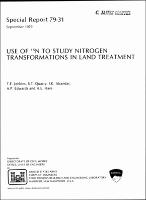Please use this identifier to cite or link to this item:
https://hdl.handle.net/11681/12038| Title: | Use of ¹⁵N to study nitrogen transformations in land treatment |
| Authors: | University of New Hampshire Jenkins, Thomas F. Quarry, Steven T. Iskandar, I. K. (Iskandar Karam), 1938- Edwards, Arthur P. Hare, Helen E. |
| Keywords: | Land treatment Land waste disposal Nitrogen Isotopes Nitrogen isotopes ¹⁵N Tracer studies Tracers Wastewater treatment Waste disposal Soil chemistry |
| Publisher: | Cold Regions Research and Engineering Laboratory (U.S.) Engineer Research and Development Center (U.S.) |
| Series/Report no.: | Special report (Cold Regions Research and Engineering Laboratory (U.S.)) ; 79-31. |
| Description: | Special Report Abstract: The objective of this study was to compare different strategies of using ¹⁵N as a tracer to describe the fate of wastewater N in land application of wastewater. Four soil columns were packed with Windsor sandy loam soil and covered with forage grass. The columns were treated with 7.5 cm of either tapwater or wastewater according to four experimental strategies. The strategies varied the treatment given the soil prior to application of the ¹⁵N label, the schedule and amounts of the applied ¹⁵N label, and the type ofwater used for subsequent column leaching. Soil solution at depth and leachate were analyzed weekly for concentration and ¹⁵N content of nitrate and ammonium. Plant samples were obtained periodically throughout the experiment and, together with soil samples collected at the end of the experiment, analyzed for total nitrogen content and ¹⁵N/¹⁴N ratios. The results indicate that nitrification occurred rapidly in the column preconditioned with wastewater, and the resulting labeled nitrogen moved in a narrow band through the soil profile. In the other columns, nitrification was delayed, resulting in the formation of a lower total amount of labeled nitrate as well as a more diffuse band. A strategy consisting of a single application of the ¹⁵N label in wastewater with a high enrichment, preceded and followed by wastewater applications, permitted the monitoring of nitrification, movement of NO3- in the soil and plant uptake subsequent to application of the label. The other strategies were found to be useful for obtaining specific types of information relative to the operation of land treatment systems and other soil N pathways. |
| Rights: | Approved for public release; distribution is unlimited. |
| URI: | http://hdl.handle.net/11681/12038 |
| Appears in Collections: | Special Report |
Files in This Item:
| File | Description | Size | Format | |
|---|---|---|---|---|
| SR-79-31.pdf | 2.07 MB | Adobe PDF |  View/Open |